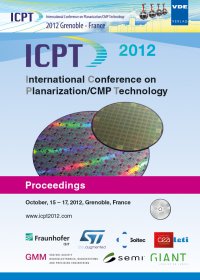Additive/Abrasive Interactions in Solution: Investigation of the Surface Chemistry and Adsorption Behaviour of CMP Abrasives
Konferenz: ICPT 2012 - International Conference on Planarization / CMP Technology
15.10.2012-17.10.2012 in Grenoble, France
Tagungsband: ICPT 2012
Seiten: 6Sprache: EnglischTyp: PDF
Persönliche VDE-Mitglieder erhalten auf diesen Artikel 10% Rabatt
Autoren:
England, Ashley N.; Remsen, Edward E. (Bradley University, Mund-Lagowski Department of Chemistry & Biochemistry, Peoria, IL 61625, USA)
Rawat, Ashwani; Moinpour, Mansour (Intel Corporation, Santa Clara, CA 95052, USA)
Inhalt:
The application of fluorescence correlation spectroscopy (FCS) as a tool for the study of additive-abrasive particle interactions in CMP slurries is described. FCS provides quantitative determinations of the extent of binding between additives and abrasive particles by characterizing the competitive adsorption of the additive and a fluorescent probe molecule, Alexa fluor 546 (A546) at the surface of a silica abrasive particle. Analysis of the adsorption of benzatriazole (BTA) on colloidal silica confirms the displacement of A546 by added BTA. However, added glycine and the analogous amino acid alanine both enhance adsorption of A546 by colloidal silica. Based on consideration of the ionization state of the amino acids and the surface charge of the colloidal silica, hydrogen bonding is favourable at low pH, which leads to binding of A546 via the protonated amino group of the amino acids. The results of FCS analyses presented in this study demonstrate that this method is capable of detailed investigations of complex binding and adsorptive interactions occurring in CMP slurries. Keywords: Single-molecule Spectroscopy, Fluorescence Correlation Spectroscopy, FCS, Adsorption, Adsorption Isotherm, Chemical-mechanical Planarization, BTA, glycine, alanine


